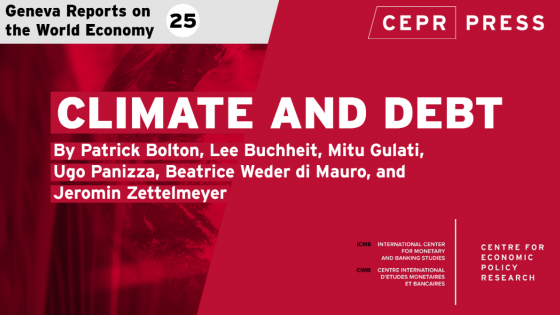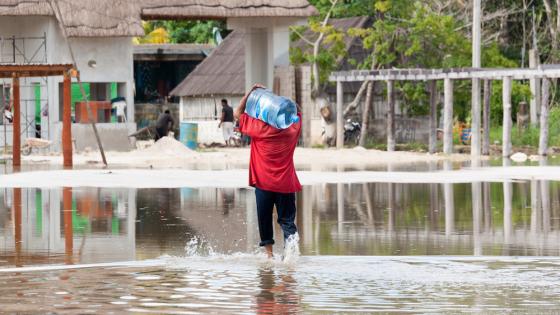While our attention has been diverted to issues of war, energy, pestilence, and a passing monarch, 2022 promises to become another record year of extreme weather events. Droughts, heatwaves, floods, storms… the list could go on. Little doubt remains that many of these calamities are the result of man-made climate change.
But not all is bleak. The US, a perennial climate change laggard among rich countries, passed a wide-ranging climate bill in August aimed at cutting greenhouse gas (GHG) emissions. And Europe’s energy crisis will accelerate that region’s turn to renewables.
There may therefore be some cause for cautious optimism in the advanced world. But poor countries are cash-strapped and will fail to meet their Nationally Determined Contributions under the Paris Climate Accord. A debt crisis looms in many poor countries as interest rates rise and the world dips into recession (Akhtar et al. 2022). Given many urgent and immediate social needs, we cannot expect that poor nations will be able to meaningfully mitigate an impending climate disaster, which was fundamentally caused by much richer countries.
This matters because poor countries’ GHG emissions are rising quickly. Sub-Saharan Africa and South Asia accounted for a combined 30% of emissions by OECD countries as recently as 2000 (Climate Watch 2022). This share has risen to close to 60% and, on current trends, will surpass 100% in the early 2040s. High population growth in poorer countries will see to that.
The rich world needs to financially support the Global South to make more progress (Schoenmaker and Volz forthcoming). Unfortunately, we are unlikely to see OECD countries pay for the necessary mitigation investments in poorer countries anytime soon. Their own budgets have already been hammered by a pandemic, an energy crisis, and a looming recession, and the political will to increase international climate finance is lacking, despite the rhetoric.
Yet, waiting is not an option. This is because in battling climate change, the profile of emissions reductions is more important than much touted ‘net zero’ dates. GHGs linger in the atmosphere for decades. What really matters is the long-term stock of GHGs in the atmosphere. A tonne of CO2 emitted today will contribute more to global heating that a tonne emitted in 2040. Accordingly, aggressively frontloading emissions reduction emissions is of the essence (Fankhauser et al. 2022).
It can be done. The G20 should form an F2C2 agency, short for Finance Facility against Climate Change. F2C2 would follow the successful example of the International Finance Facility for Immunisation (IFFIm). Since 2006, IFFIm operates based on the idea that private investors and government donors can work together to have a greater, more immediate impact on global health. Funds raised through IFFIm’s bond issuance are earmarked for immunisation programmes in poor countries. Like emissions reduction, vaccinations are a common good where frontloading is the precondition for collective success.
F2C2 bonds can follow IFFIm’s successful blueprint. Effectively, the bonds are backed by rich nations’ commitments of future disbursements to cover debt service obligations of the F2C2 bonds. This allows the necessary frontloading of climate spending in poor countries, while minimising the short-term impact on donor countries’ budgets.
The rating agencies will threat the commitments to support F2C2 on par with the full faith and credit of the sovereign making that promise. As a result, F2C2 bonds will carry ratings in the AA or even AAA range. The exact rating will depend on the size and composition of rich countries’ commitments for future funding. We know the way rating agencies will analyse F2C2, because that is how they have rated securities issued by IFFIm (IFFIm 2022) and, on a much larger scale, also by assigning AAA ratings to vast amounts of NextGenerationEU (NGEU) bonds. They are fundamentally supported by nothing other than unenforceable promises many years down the road. F2C2 issuance will be snapped up by investors eager to fill their books with truly green and highly rated financial instruments.
The financial management of F2C2 bonds could be managed by the World Bank. The World Bank is the only truly global development institution. In fact, it already runs the treasury operations for IFFIm. The World Bank should be keen to take on that prestigious task – all the more so as it has recently been scolded by the US government for falling well short of what needs to be done to confront the climate challenge (Yellen 2022).
It is true that F2C2 will push the financial burden of fighting climate change to future generations of rich-country taxpayers. Some may consider this fair as they would be among the main beneficiaries if we were able to arrest global warming. It may also be justifiable because rich countries have, since the onset of the Industrial Revolution, emitted the lion’s share of GHGs that are still floating around in the atmosphere.
But whatever our sense of intergenerational fairness may be, there are few good alternatives, and we need to use all practical solutions. Time is running out. We cannot afford to wait until public finances miraculously improve in rich and poor countries alike. Confronting climate change has become a make-or-break priority requiring decisive collective action. F2C2 provides a framework that brings us closer towards securing a viable future.
References
Akhtar, S, J Haas and U Volz (2022), “Debt Relief for A Green and Inclusive Recovery”, T20 Policy Brief. Task Force 7 on International Finance and Economic Recovery.
Climate Watch (2022), “Historical GHG Emissions”, World Resources Institute.
Fankhauser, S, S M Smith, M Allen et al. (2022), “The Meaning of Net Zero and How to Get it Right”, Nature Climate Change 12: 15–21.
IFFIm – International Finance Facility for Immunisation (2022), Ratings Reports: The International Finance Facility for Immunisation (IFFIm) is Rated AA-/Aa1/AA.
Schoenmaker, D and U Volz (eds) (forthcoming), Scaling Up Sustainable Finance and Investment in the Global South, CEPR Press.
Yellen, J L (2022), “Remarks by Secretary of the Treasury Janet L. Yellen at the Center for Global Development”, 6 October.






